Performance Test and Microstructure of Modified PVC Aggregate-Hybrid Fiber Reinforced Engineering Cementitious Composite (ECC)
Abstract
:1. Introduction
2. Materials and Methods
2.1. Materials
2.2. Specimen Preparation
2.3. Test Device and Methods
2.3.1. Compressive Strength and Splitting Tensile Strength Test
2.3.2. Water Absorption Test
2.3.3. Drop Hammer Impact Test
2.3.4. Scanning Electron Microscopy and Nuclear Magnetic Resonance Test
3. Results and Discussion
3.1. Compressive Strength, Splitting Tensile Strength, Failure Process
3.2. Water Absorption Rate
3.3. Impact Failure Energy
4. Discussion
4.1. Size Effect
4.2. Shrinkage Performance
4.3. Creep and Rheological Properties
5. Conclusions
- The strength of the ECC matrix with added PVC aggregate before and after modification decreases but adding modified PVC aggregate can effectively delay the effect of directly adding PVC aggregate on strength reduction. The results demonstrate that the compressive strength of the ECC matrix decreases as 0.5% PP fiber is added, but the splitting tensile strength increases. With the increase of the PVA fiber content, the compressive strength decreases significantly, which is 18.65% when the volume content is 2%, but the splitting tensile strength is increased by 100.5%. The hybrid effect coefficients based on the compressive strength and the splitting tensile strength of 0.5% PP and 1.5% PVA fiber groups are 0.993 and 0.882, respectively. The compressive strength and the splitting tensile strength of the group added with hybrid fiber-modified PVC aggregate decreases slowly as more modified PVC aggregate is added, which are 35.28 MPa and 3.62 MPa, respectively.
- The compressive failure mode of the ECC matrix is similar to brittle failure. Adding PVC aggregate before and after modification can decrease the elastic modulus and effectively improve brittleness, but modified PVC aggregate has a more obvious effect. With the increase in the PVA fiber content, there are fewer macro penetration fracture planes on the specimen surface and the elastic modulus decreases, indicating that the brittleness has been effectively improved. As 2% PVA fiber is added, the failure form is the most complete, there is no penetration fracture plane, and the brittleness basically disappears. The failure mode of adding 1.5% PVA and 0.5% PP fibers is similar to that of adding 1.5% PVA fiber. However, there are few cracks on the compression surface, and the elastic modulus is a little bit lower, which indicates that its brittleness improvement effect is slightly better than that of 1.5% PVA fiber, but much worse than that of 2% PVA fiber. The macro penetration fracture plane and spalling of specimens with added hybrid fiber and 30% modified PVC aggregate are worse than that added with 2% PVA fiber, the elastic modulus and the brittleness improvement ability is second only to it.
- The water absorption of the ECC matrix with added modified and unmodified PVC aggregate increases. Adding modified PVC aggregate can effectively decrease the porosity caused by directly mixing PVC aggregate. Regardless of the kind of fiber and the content, the water absorption increases. As 1.5% PVA and 0.5% PP fibers are added, the water absorption is the largest, and the hybrid effect coefficient based on water absorption is 0.987. As more modified PVC aggregate is added, the water absorption of the ECC added with hybrid fiber and modified PVC aggregate increases, reaching 2.441%.
- ECC matrix has a large brittleness, and the impact failure energy with the added modified and unmodified PVC aggregate obviously increases. The modified PVC aggregate has a more significant reinforcement effect. The impact failure energy of 0.5% PP fiber is increased by 1.33 times, the effect is general. However, PVA fiber increases the impact failure energy more obviously. The impact failure energy is increased nearly by 276 times when the mixing content of PVA fiber is 2%. The hybrid effect coefficient of 0.5% PP and 1.5% PVA fibers based on impact failure energy is 0.601. The impact failure energy of the ECC added with hybrid fiber and modified PVC aggregate increases as more modified PVC aggregate is added, reaching 13,747.12 J.
Author Contributions
Funding
Institutional Review Board Statement
Informed Consent Statement
Data Availability Statement
Conflicts of Interest
References
- Opon, J.; Henry, M. An indicator framework for quantifying the sustainability of concrete materials from the perspectives of global sustainable development. J. Clean. Prod. 2019, 218, 718–737. [Google Scholar] [CrossRef]
- Marcalikova, Z.; Cajka, R.; Bilek, V.; Bujdos, D.; Sucharda, O. Determination of Mechanical Characteristics for Fiber-Reinforced Concrete with Straight and Hooked Fibers. Crystals 2020, 10, 545. [Google Scholar] [CrossRef]
- Brandt, A.M. Fibre reinforced cement-based (FRC) composites after over 40 years of development in building and civil engi neering. Compos. Struct. 2008, 86, 3–9. [Google Scholar] [CrossRef]
- Basalo, F.J.D.C.Y.; Matta, F.; Nanni, A. Fiber reinforced cement-based composite system for concrete confinement. Constr. Build. Mater. 2012, 32, 55–65. [Google Scholar] [CrossRef]
- Pujadas, P.; Blanco, A.; Cavalaro, S.H.P.; De La Fuente, A.; Aguado, A. The need to consider flexural post-cracking creep behavior of macro-synthetic fiber reinforced concrete. Constr. Build. Mater. 2017, 149, 790–800. [Google Scholar] [CrossRef]
- Li, V.C. On engineered cementitious composites (ECC) a review of the material and its applications. JACT. 2003, 1, 215–230. [Google Scholar]
- Singh, M.; Saini, B.; Chalak, H. Performance and composition analysis of engineered cementitious composite (ECC) – A review. J. Build. Eng. 2019, 26, 100851. [Google Scholar] [CrossRef]
- Li, V.C. Tailoring ECC for Special Attributes: A Review. Int. J. Concr. Struct. Mater. 2012, 6, 135–144. [Google Scholar] [CrossRef] [Green Version]
- Li, V.C.; Wang, S.; Wu, C. Tensile strain-hardening behavior of polyvinyl alcohol engineered cementitious composite (PVA-ECC). ACI. Mater. J. 2001, 98, 483–492. [Google Scholar]
- Lee, C.; Khan, M.; Zhang, Y.; Rana, M.M. Compressive performance of ECC-concrete encased high strength steel composite columns. Eng. Struct. 2020, 213, 110567. [Google Scholar] [CrossRef]
- Wang, Q.; Yi, Y.; Ma, G.; Luo, H. Hybrid effects of steel fibers, basalt fibers and calcium sulfate on mechanical performance of PVA-ECC containing high-volume fly ash. Cem. Concr. Compos. 2019, 97, 357–368. [Google Scholar] [CrossRef]
- Zhang, Z.; Zhang, Q. Matrix tailoring of Engineered Cementitious Composites (ECC) with non-oil-coated, low tensile strength PVA fiber. Constr. Build. Mater. 2018, 161, 420–431. [Google Scholar] [CrossRef]
- Zhu, Z.; Tan, G.; Zhang, W.; Wu, C. Preliminary Analysis of the Ductility and Crack-Control Ability of Engineered Ce-mentitious Composite with Superfine Sand and Polypropylene Fiber (SSPP-ECC). Materials 2020, 13, 2609. [Google Scholar] [CrossRef]
- Lin, J.-X.; Song, Y.; Xie, Z.-H.; Guo, Y.-C.; Yuan, B.; Zeng, J.-J.; Wei, X. Static and dynamic mechanical behavior of engineered cementitious composites with PP and PVA fibers. J. Build. Eng. 2020, 29, 101097. [Google Scholar] [CrossRef]
- Wang, Y.; Jian, X.; Yu, J.; Ye, J.; Dong, F. Development of gypsum-based composites with tensile strain-hardening character-istics. J. Am. Ceram. Soc. 2020, 103, 7115–7126. [Google Scholar] [CrossRef]
- Zhou, J.W.; Yu, B.Y.; Gao, Y.X.; Yang, W.; Cheng, B.J. Effect of epoxy emulsion on properties of ultra-high toughness cementitious composites. J. Physics: Conf. Ser. 2021, 1777, 012011. [Google Scholar] [CrossRef]
- Zhang, Z.; Liu, J.-C.; Xu, X.; Yuan, L. Effect of sub-elevated temperature on mechanical properties of ECC with different fly ash contents. Constr. Build. Mater. 2020, 262, 120096. [Google Scholar] [CrossRef]
- Guan, X.; Li, Y.; Liu, T.; Zhang, C.; Li, H.; Ou, J. An economical ultra-high ductile engineered cementitious composite with large amount of coarse river sand. Constr. Build. Mater. 2019, 201, 461–472. [Google Scholar] [CrossRef]
- Huang, B.-T.; Wu, J.-Q.; Yu, J.; Dai, J.-G.; Leung, C.K. High-strength seawater sea-sand Engineered Cementitious Composites (SS-ECC): Mechanical performance and probabilistic modeling. Cem. Concr. Compos. 2020, 114, 103740. [Google Scholar] [CrossRef]
- Alaloul, W.S.; Musarat, M.A.; Tayeh, B.A.; Sivalingam, S.; Bin Rosli, M.F.; Haruna, S.; Khan, M.I. Mechanical and deformation properties of rubberized engineered cementitious composite (ECC). Case Stud. Constr. Mater. 2020, 13, e00385. [Google Scholar] [CrossRef]
- Mohammed, B.S.; Yen, L.Y.; Haruna, S.; Huat, M.L.S.; Abdulkadir, I.; Al-Fakih, A.; Liew, M.S.; Zawawi, N.A.W.A. Effect of Elevated Temperature on the Compressive Strength and Durability Properties of Crumb Rubber Engineered Cementitious Composite. Materials 2020, 13, 3516. [Google Scholar] [CrossRef]
- Senhadji, Y.; Siad, H.; Escadeillas, G.; Benosman, A.S.; Chihaoui, R.; Mouli, M.; Lachemi, M. Physical, mechanical and thermal properties of lightweight composite mortars containing recycled polyvinyl chloride. Constr. Build. Mater. 2019, 195, 198–207. [Google Scholar] [CrossRef]
- Huang, B.; Shu, X.; Cao, J. A two-staged surface treatment to improve properties of rubber modified cement composites. Constr. Build. Mater. 2013, 40, 270–274. [Google Scholar] [CrossRef]
- Onuaguluchi, O. Effects of surface pre-coating and silica fume on crumb rubber-cement matrix interface and cement mortar properties. J. Clean. Prod. 2015, 104, 339–345. [Google Scholar] [CrossRef]
- Hu, S.; Xu, Y. Preparation, Performance Test, and Microstructure of Composite Modified Reinforced Concrete. Adv. Civ. Eng. 2020, 2020, 1–14. [Google Scholar] [CrossRef]
- Al-Tayeb, M.M.; Ismail, H.; Dawoud, O.; Wafi, S.R.; Al Daoor, I. Ultimate failure resistance of concrete with partial replace-ments of sand by waste plastic of vehicles under impact load. Int. J. Sustain. Built Environ. 2017, 6, 610–616. [Google Scholar] [CrossRef]
- Weipei, X.; Xiaoyuan, L.; Zhishu, Y.; Cheng, H.; Haopeng, L. Effects of different damage sources on pore structure change characteristics of basalt fiber reinforced concrete. Acta Mater. Compos. Sinica. 2020, 37, 2285–2293. [Google Scholar]
- Hucka, V.; Das, B. Brittleness determination of rocks by different methods. Int. J. Rock Mech. Min. Sci. Géoméch. Abstr. 1974, 11, 389–392. [Google Scholar] [CrossRef]
- Thorneycroft, J.; Orr, J.; Savoikar, P.; Ball, R. Performance of structural concrete with recycled plastic waste as a partial re-placement for sand. Constr Build. Mater. 2018, 161, 63–69. [Google Scholar] [CrossRef]
- Zhang, Q.; Shu, X.; Yang, Y.; Ran, Q. Adsorption of Superplasticizer and its Effect on Viscosity of Cement-Silica Fume Paste. J. Chin. Ceram. Soc. 2020, 48, 1716–1721. [Google Scholar]
- Wang, D.; Ju, Y.; Shen, H.; Xu, L. Mechanical properties of high performance concrete reinforced with basalt fiber and poly-propylene fiber. Constr Build. Mater. 2019, 197, 464–473. [Google Scholar] [CrossRef]
- Yang, L.; Yao, Z.; Xue, W.; Wang, X.; Kong, W.; Wu, T.; Wang, X. Preparation, performance test and microanalysis of hybrid fibers and microexpansive high-performance shaft lining concrete. Constr. Build. Mater. 2019, 223, 431–440. [Google Scholar] [CrossRef]
- Du, H.; Gao, H.J.; Pang, S.D. Improvement in concrete resistance against water and chloride ingress by adding graphene nanoplatelet. Cem. Concr. Res. 2016, 83, 114–123. [Google Scholar] [CrossRef]
- Da Costa, F.; Righi, D.; Graeff, A.; Filho, L.D.S. Experimental study of some durability properties of ECC with a more environmentally sustainable rice husk ash and high tenacity polypropylene fibers. Constr. Build. Mater. 2019, 213, 505–513. [Google Scholar] [CrossRef]
- Zhang, Z.; Qian, S.; Ma, H. Investigating mechanical properties and self-healing behavior of micro-cracked ECC with different volume of fly ash. Constr. Build. Mater. 2014, 52, 17–23. [Google Scholar] [CrossRef]
- Siddique, R. Utilization of silica fume in concrete: Review of hardened properties. Resour. Conserv. Recycl. 2011, 55, 923–932. [Google Scholar] [CrossRef]
- Rossignolo, J.A. Interfacial interactions in concretes with silica fume and SBR latex. Constr. Build. Mater. 2009, 23, 817–821. [Google Scholar] [CrossRef]
- Zhao, S.; Zhang, Q. Effect of Silica Fume in Concrete on Mechanical Properties and Dynamic Behaviors under Impact Loading. Materials 2019, 12, 3263. [Google Scholar] [CrossRef] [Green Version]
- Saxena, R.; Siddique, S.; Gupta, T.; Sharma, R.K.; Chaudhary, S. Impact resistance and energy absorption capacity of concrete containing plastic waste. Constr. Build. Mater. 2018, 176, 415–421. [Google Scholar] [CrossRef]
- Lepech, M.; Li, V. Preliminary Findings on Size Effect in Ecc Structural Members in Flexure. Brittle Matrix Composites 7 2003, 7, 57–66. [Google Scholar] [CrossRef] [Green Version]
- Gao, S.; Wang, Z.; Wang, W.; Qiu, H. Effect of shrinkage-reducing admixture and expansive agent on mechanical properties and drying shrinkage of Engineered Cementitious Composite (ECC). Constr. Build. Mater. 2018, 179, 172–185. [Google Scholar] [CrossRef]
- Li, K.; Yang, C.; Zhao, Y.; Pan, Y.; Wang, G.; Zheng, Y.; Xu, F. Study on the creep behavior of PVA-ECC based on fraction al-differential rheological model. Constr. Build. Mater. 2020, 230, 117064. [Google Scholar] [CrossRef]
- Şahmaran, M.; Bilici, Z.; Ozbay, E.; Erdem, T.K.; Yucel, H.E.; Lachemi, M. Improving the workability and rheological properties of Engineered Cementitious Composites using factorial experimental design. Compos. Part. B: Eng. 2013, 45, 356–368. [Google Scholar] [CrossRef] [Green Version]
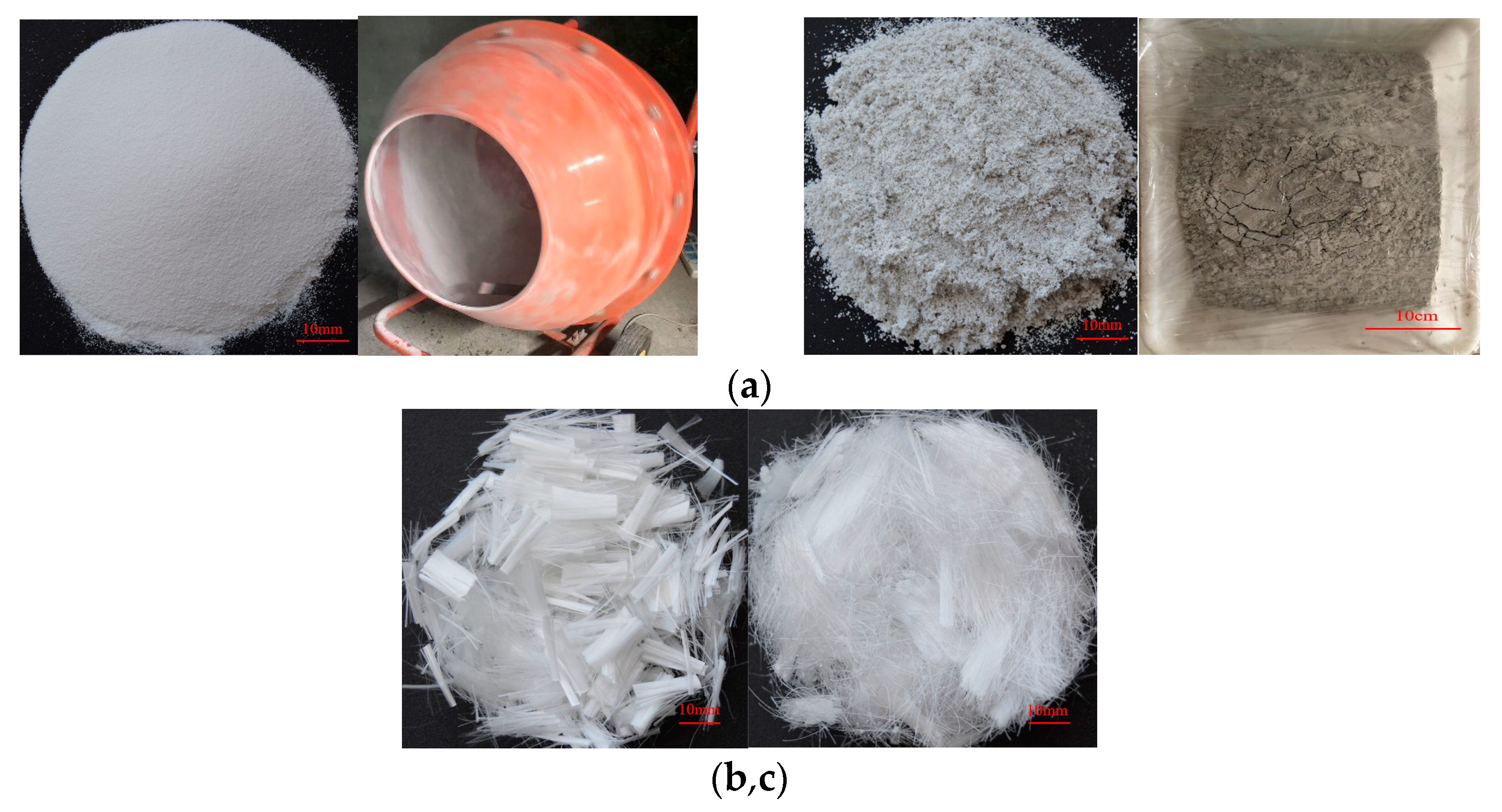
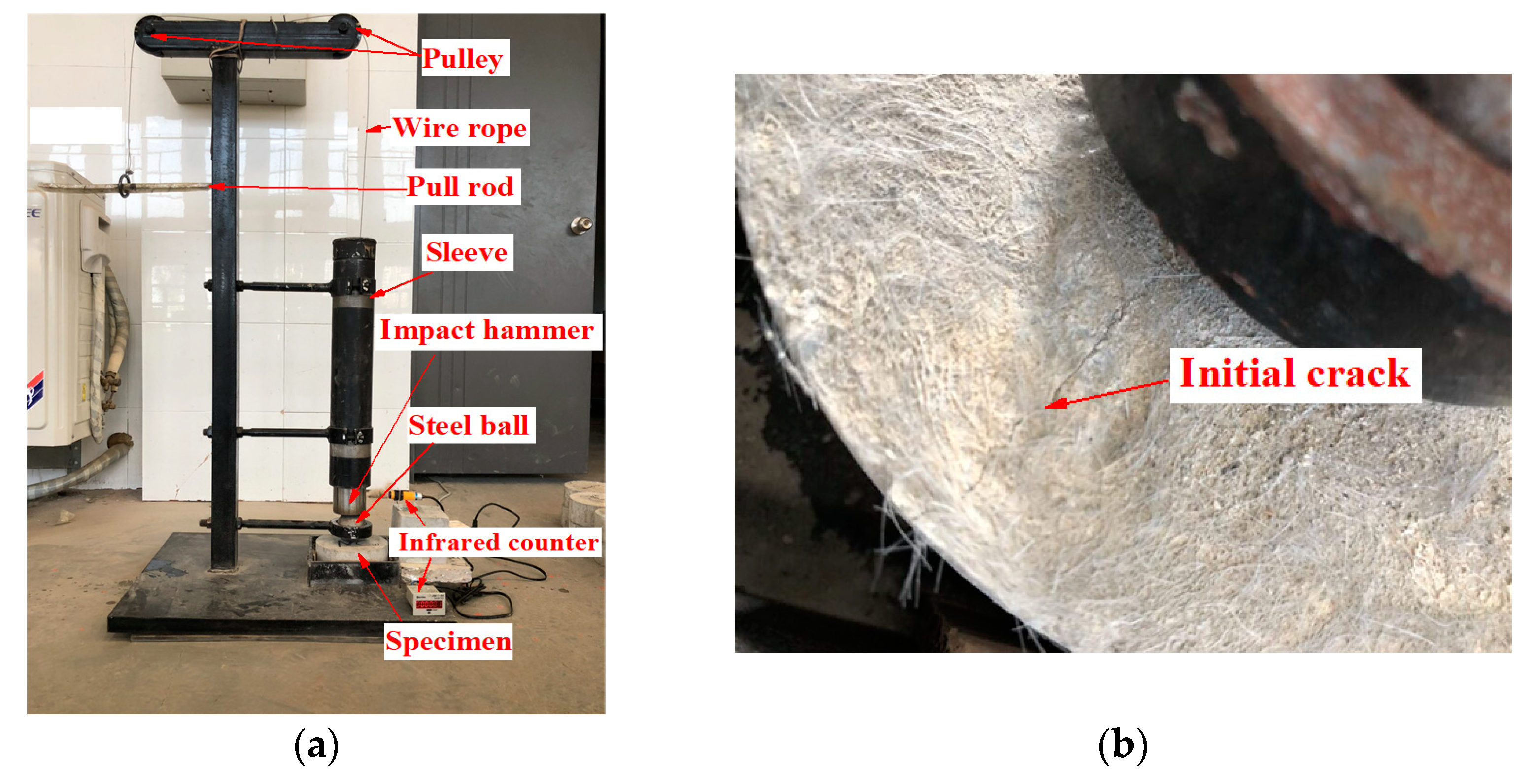
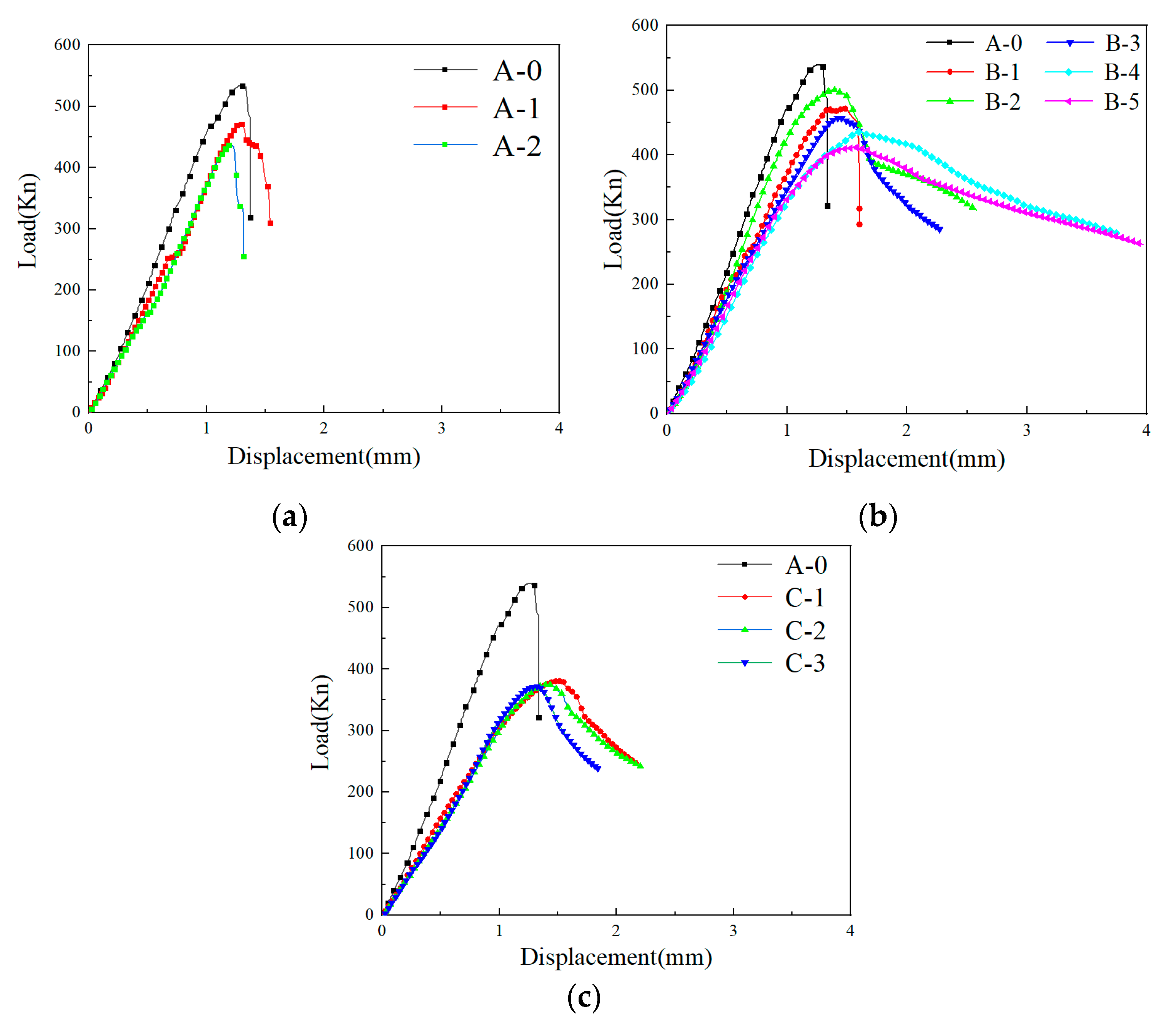
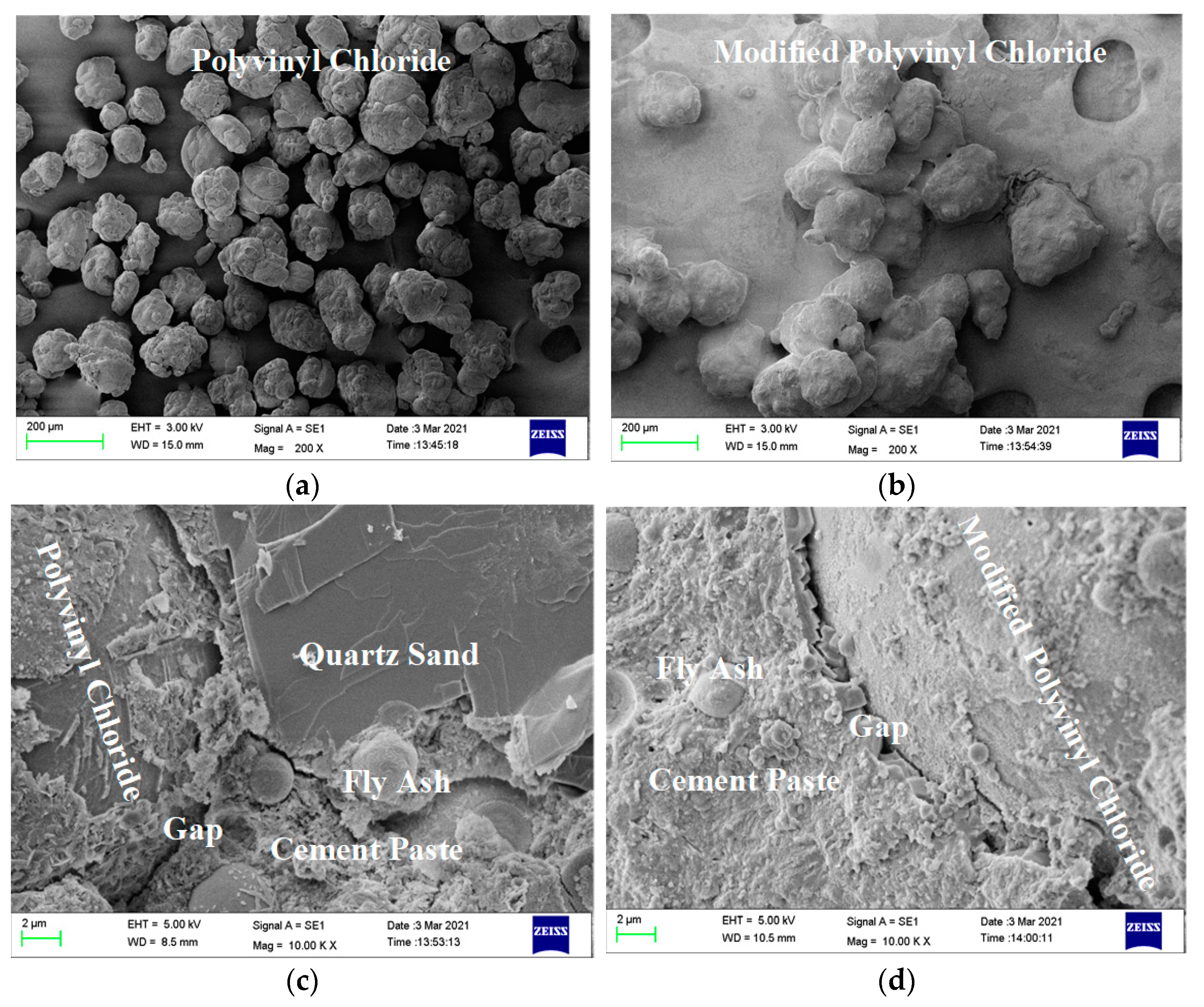
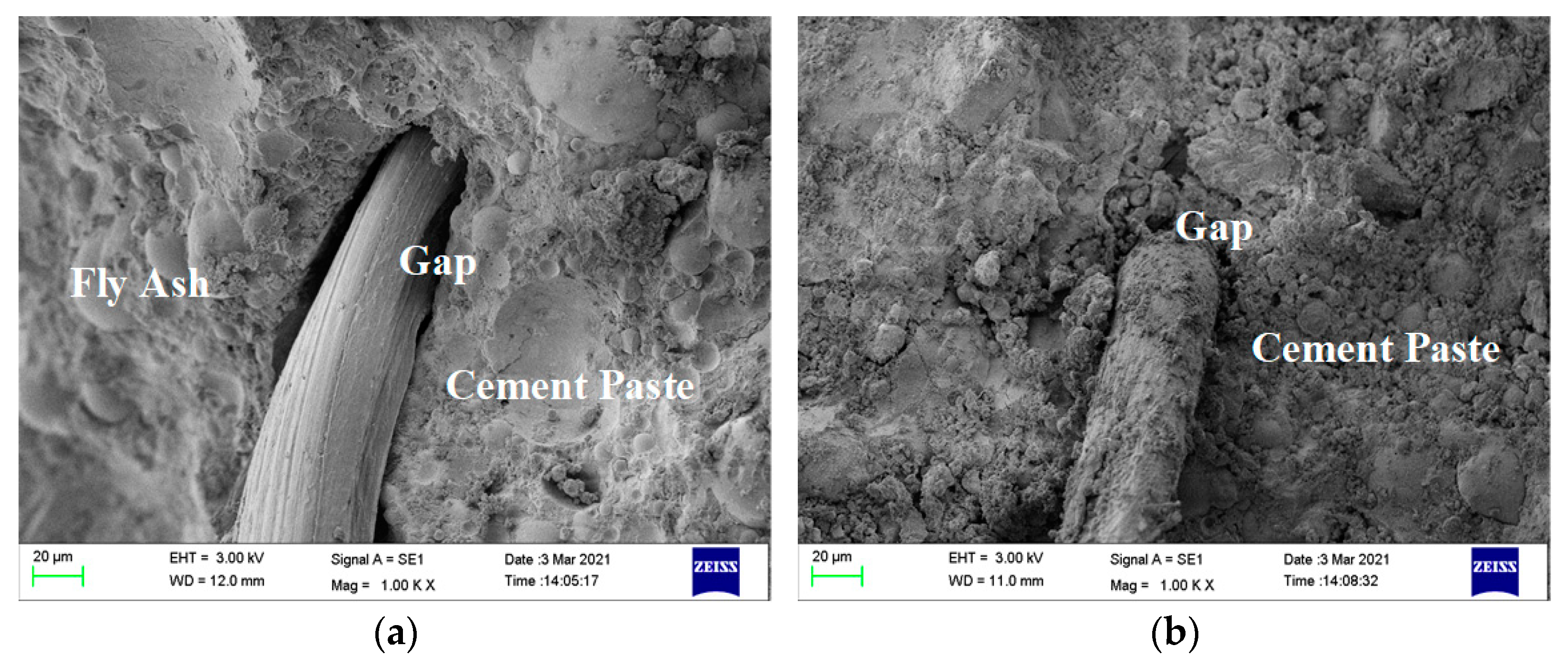
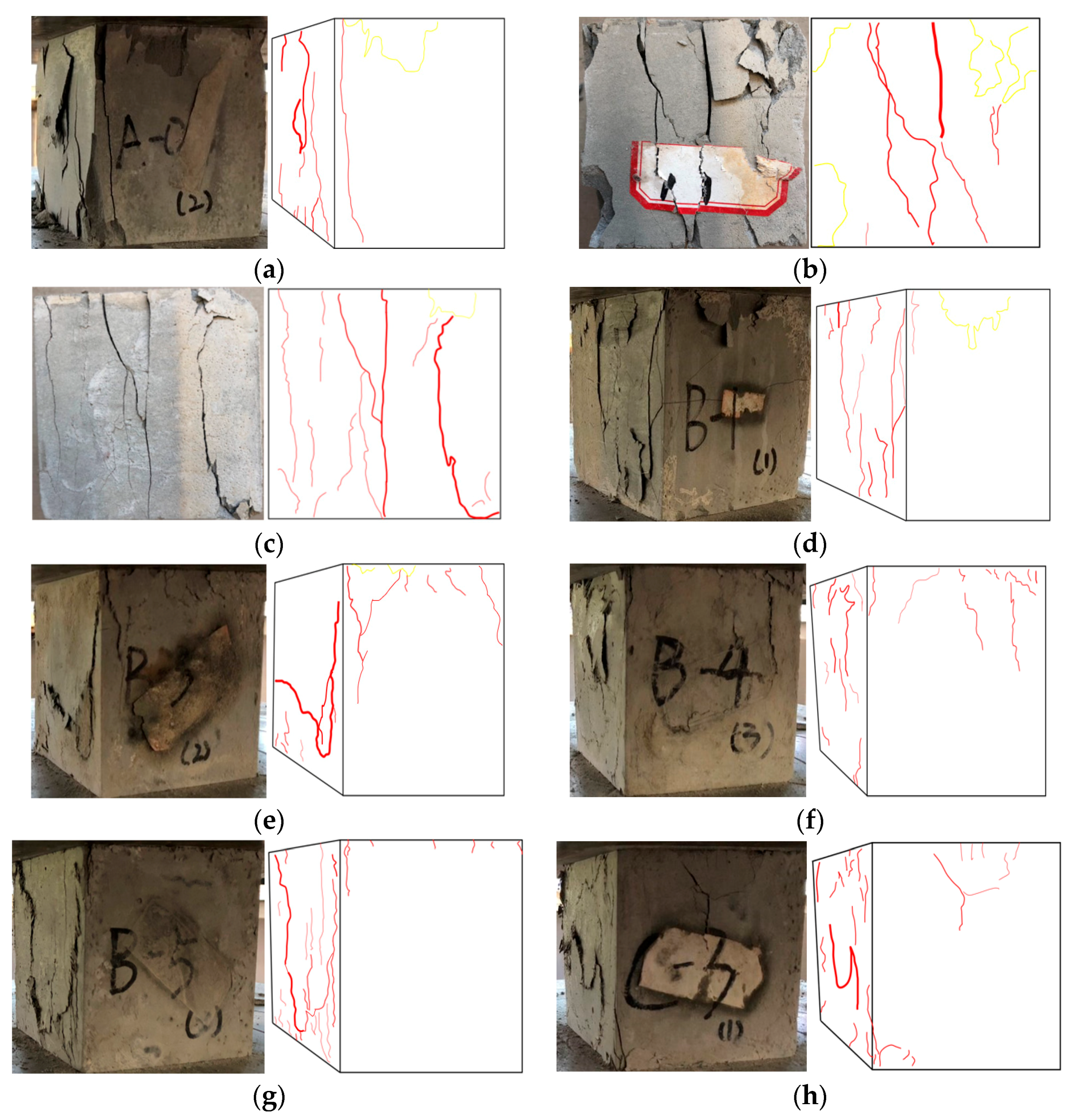

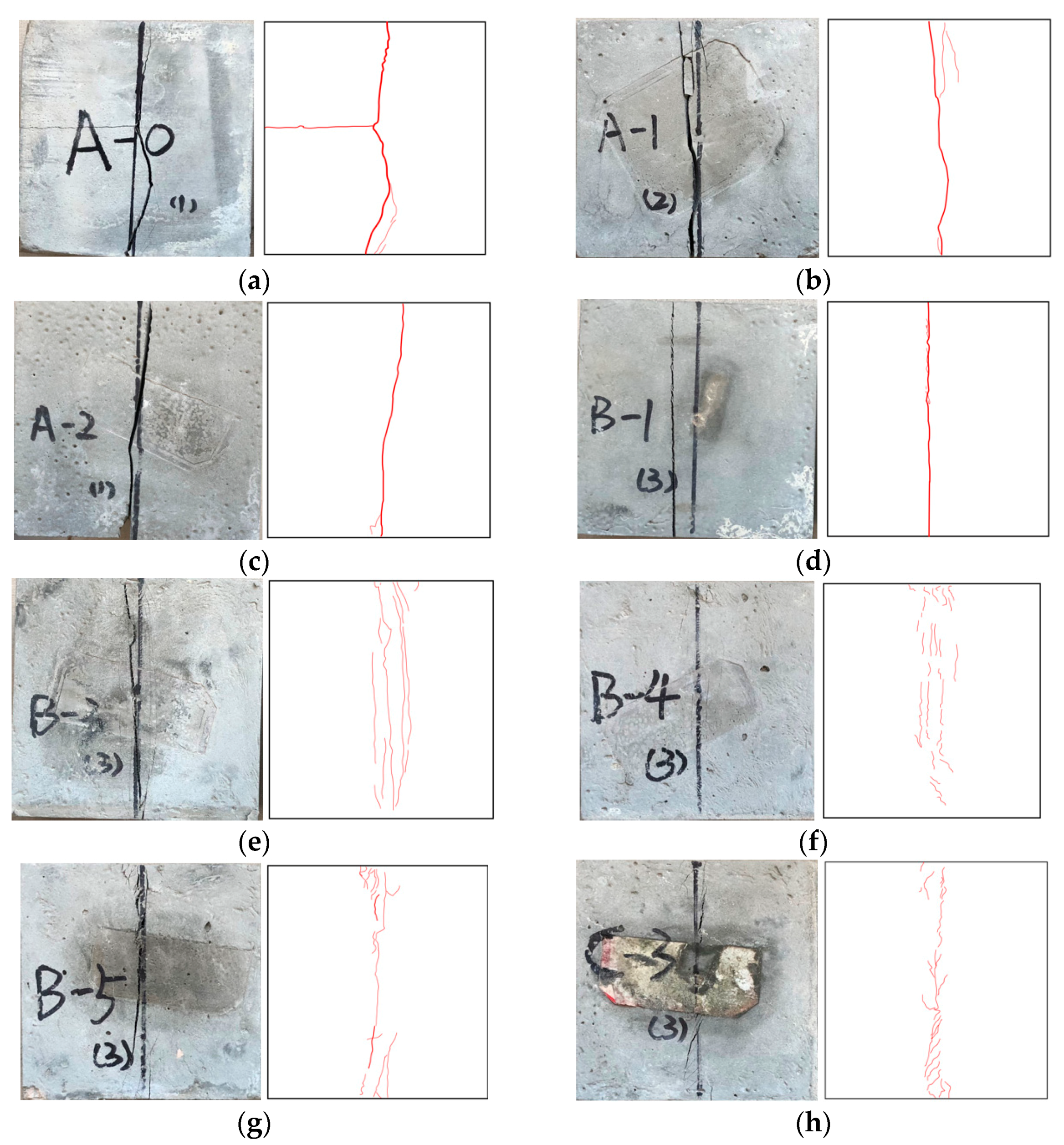
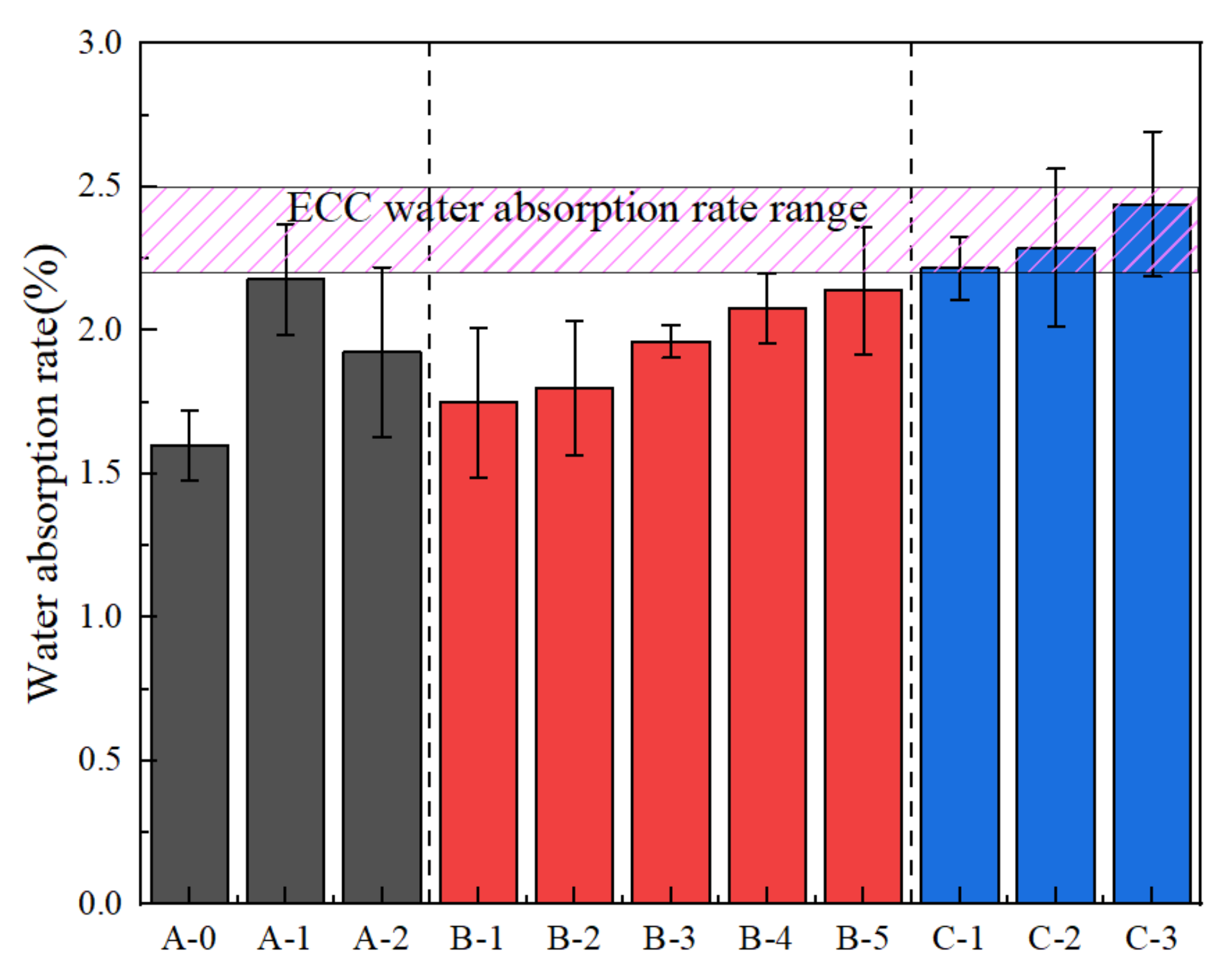
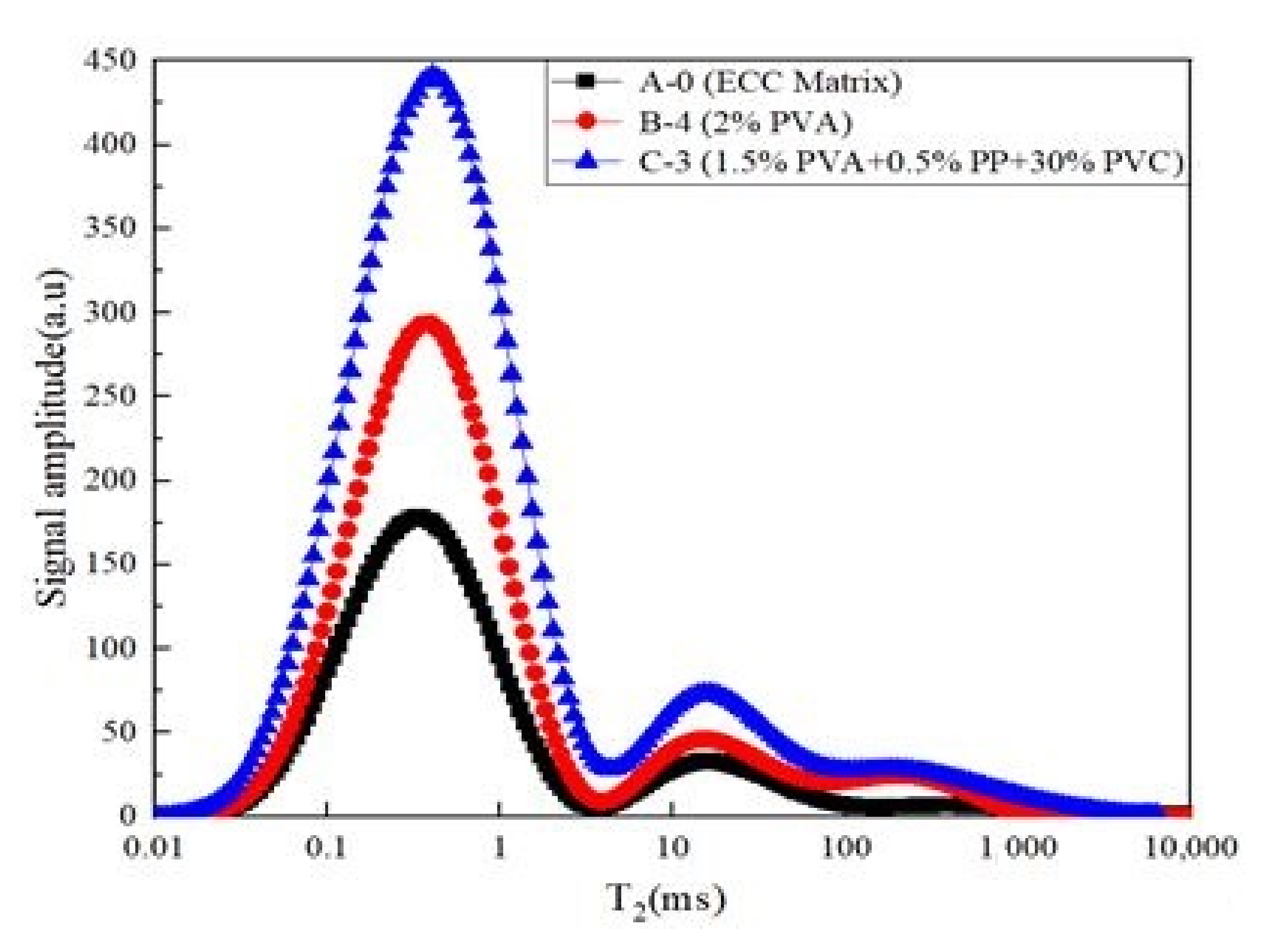

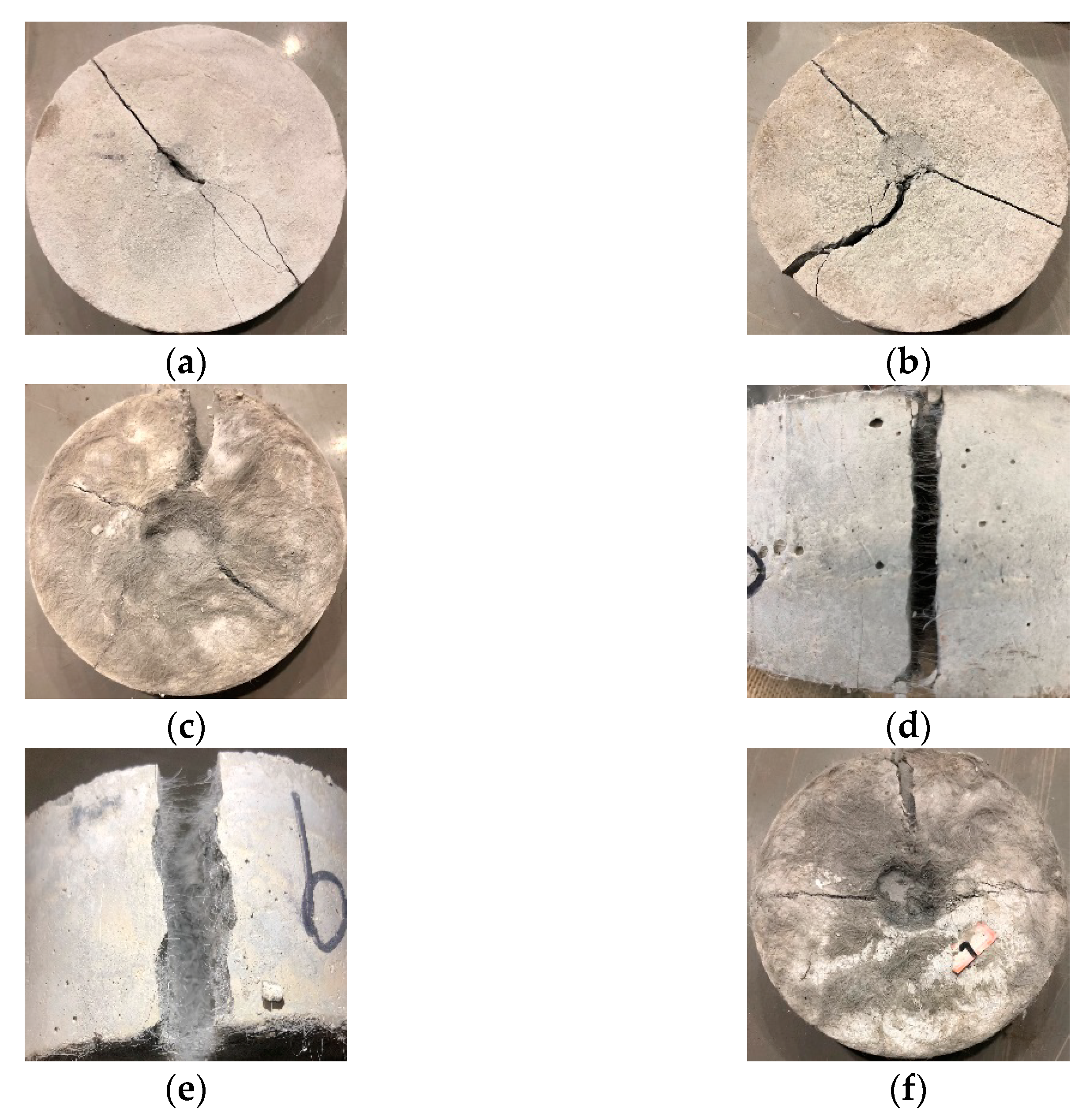
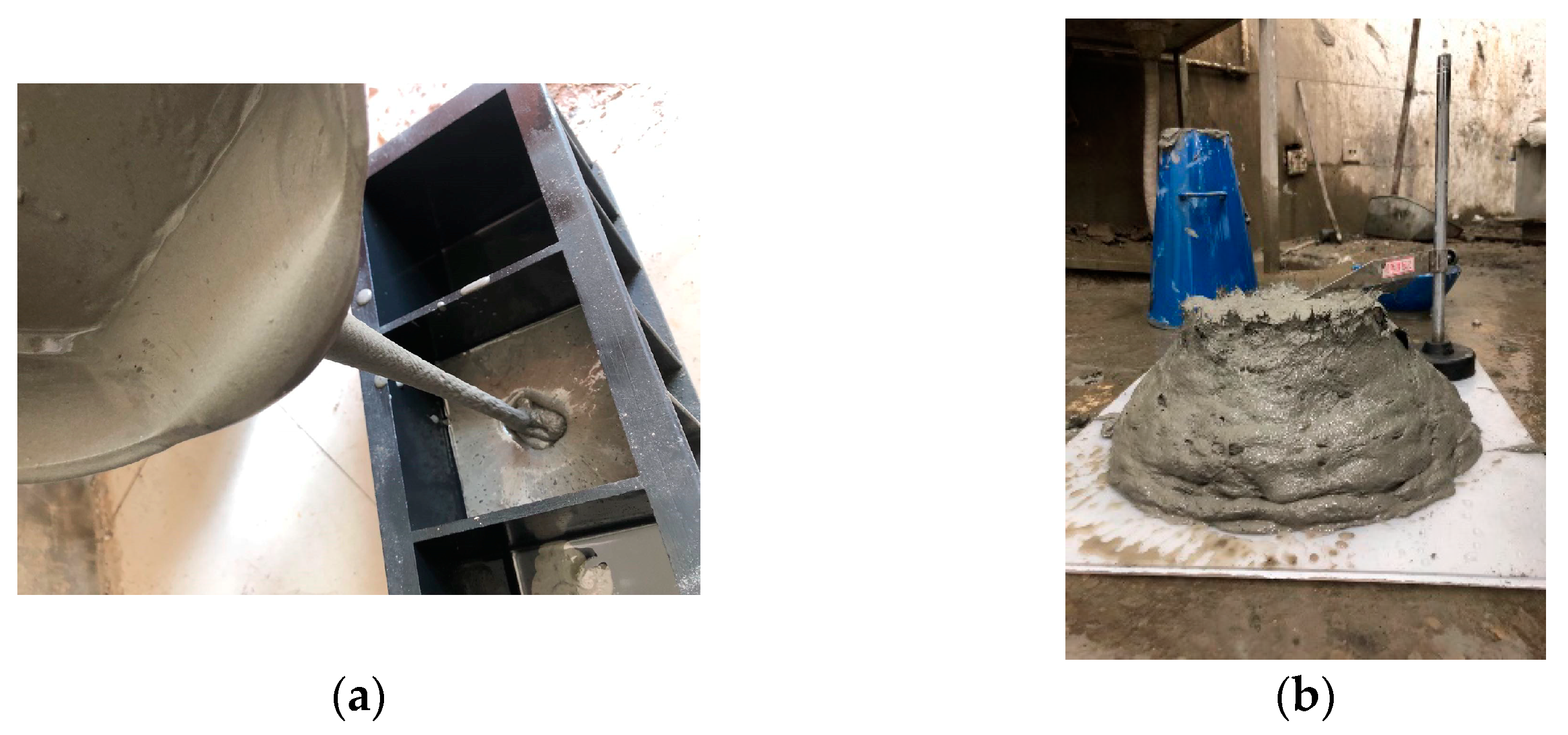
| Species | Length | Diameter | Density | Elastic Modulus | Tensile Strength | Elongation at Break |
|---|---|---|---|---|---|---|
| PP Fiber | 12 mm | 18 μm | 0.91 g/cm3 | 4.5 GPa | 500 MPa | 26.8% |
| PVA Fiber | 12 mm | 40 μm | 1.3 g/cm3 | 42.8 GPa | 1560 MPa | 6.5% |
| Specimen | A-0 | A-1 | A-2 | B-1 | B-2 | B-3 | B-4 | B-5 | C-1 | C-2 | C-3 |
|---|---|---|---|---|---|---|---|---|---|---|---|
| PVC aggregate (kg/m3) | 0 | 94.5 | 0 | 0 | 0 | 0 | 0 | 0 | 0 | 0 | 0 |
| Modified PVC aggregate (kg/m3) | 0 | 0 | 94.5 | 0 | 0 | 0 | 0 | 0 | 31.5 | 63 | 94.5 |
| PVA fiber (kg/m3) | 0 | 0 | 0 | 0 | 13 | 19.5 | 26 | 19.5 | 19.5 | 19.5 | 19.5 |
| PP fiber (kg/m3) | 0 | 0 | 0 | 4.55 | 0 | 0 | 0 | 4.55 | 4.55 | 4.55 | 4.55 |
| Sand (kg/m3) | 459 | 321.3 | 321.3 | 459 | 459 | 459 | 459 | 459 | 413.1 | 367.2 | 321.3 |
| Specimen | A-0 | A-1 | A-2 | B-1 | B-2 | B-3 | B-4 | B-5 | C-1 | C-2 | C-3 |
|---|---|---|---|---|---|---|---|---|---|---|---|
| Compressive strength (MPa) | 51.14 | 41.42 | 43.98 | 46.36 | 47.51 | 43.4 | 41.6 | 39.07 | 36.16 | 35.95 | 35.28 |
| Standard deviation | 5.07 | 3.76 | 2.45 | 4.95 | 5.23 | 4.89 | 3.10 | 2.98 | 3.02 | 4.32 | 2.13 |
| Splitting tensile strength (MPa) | 1.84 | 1.52 | 1.71 | 2.47 | 3.4 | 3.75 | 4.25 | 3.82 | 3.73 | 3.72 | 3.67 |
| Standard deviation | 0.21 | 0.26 | 0.34 | 0.21 | 0.32 | 0.28 | 0.31 | 0.19 | 0.24 | 0.20 | 0.26 |
| Elastic modulus (GPa) | 4.06 | 3.51 | 3.46 | 3.58 | 3.13 | 3.06 | 2.91 | 3.03 | 3.02 | 2.97 | 2.95 |
| Standard deviation | 0.26 | 0.34 | 0.41 | 0.42 | 0.39 | 0.27 | 0.42 | 0.21 | 0.37 | 0.19 | 0.36 |
| Brittleness index value | 27.79 | 27.25 | 25.71 | 18.77 | 13.97 | 11.57 | 9.79 | 10.23 | 9.73 | 9.66 | 9.61 |
Publisher’s Note: MDPI stays neutral with regard to jurisdictional claims in published maps and institutional affiliations. |
© 2021 by the authors. Licensee MDPI, Basel, Switzerland. This article is an open access article distributed under the terms and conditions of the Creative Commons Attribution (CC BY) license (https://creativecommons.org/licenses/by/4.0/).
Share and Cite
Hu, S.; Cai, H.; Hong, R.; Li, M.; Yao, F. Performance Test and Microstructure of Modified PVC Aggregate-Hybrid Fiber Reinforced Engineering Cementitious Composite (ECC). Materials 2021, 14, 1856. https://doi.org/10.3390/ma14081856
Hu S, Cai H, Hong R, Li M, Yao F. Performance Test and Microstructure of Modified PVC Aggregate-Hybrid Fiber Reinforced Engineering Cementitious Composite (ECC). Materials. 2021; 14(8):1856. https://doi.org/10.3390/ma14081856
Chicago/Turabian StyleHu, Shi, Haibing Cai, Rongbao Hong, Mengkai Li, and Fangxing Yao. 2021. "Performance Test and Microstructure of Modified PVC Aggregate-Hybrid Fiber Reinforced Engineering Cementitious Composite (ECC)" Materials 14, no. 8: 1856. https://doi.org/10.3390/ma14081856






